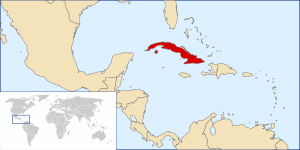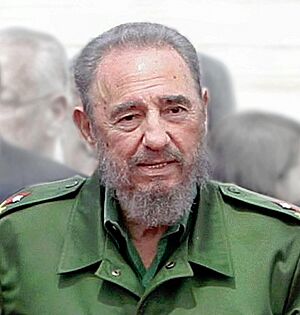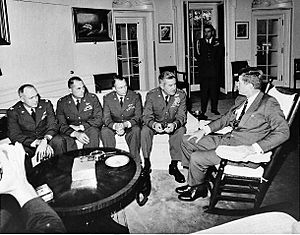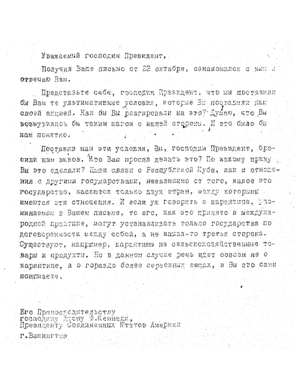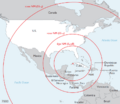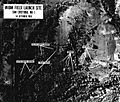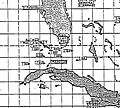Cuban Missile Crisis facts for kids
Quick facts for kids Cuban Missile Crisis |
|||||||
|---|---|---|---|---|---|---|---|
| Part of the Cold War | |||||||
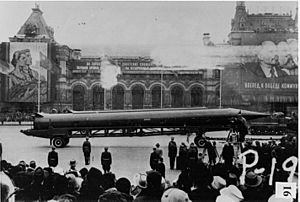 |
|||||||
|
|||||||
| Belligerents | |||||||
Supported by: |
Supported by: |
||||||
| Commanders and leaders | |||||||
|
|
||||||
| Casualties and losses | |||||||
| None | 1 U-2 spy aircraft lost 1 killed |
||||||
The Cuban Missile Crisis was a very tense time between the Soviet Union, the United States, and Cuba. It happened in 1962 during the Cold War. In Russia, it's called the Caribbean Crisis. In Cuba, it's known as the October Crisis.
This crisis began when the Soviet Union started building secret missile sites in Cuba. Cuba is very close to the United States. These missiles could reach many American cities. This event was one of the most dangerous moments of the Cold War. Many people believe it was the closest the world ever came to a nuclear war.
Before this, in 1959, Fidel Castro took power in Cuba. His new government took over American businesses there. Because of this, the US government stopped buying things from Cuba. This started an embargo (a ban on trade) against Cuba in 1962.
In October 1962, American ships blocked Soviet ships carrying missiles from reaching Cuba. This was a very risky move. Eventually, the Soviets and Cubans agreed to remove the missiles. In return, America promised not to attack Cuba. The US also secretly agreed to remove its own missiles from Turkey.
Contents
What Caused the Cuban Missile Crisis?
The Cuban Missile Crisis had several important causes. It was a mix of fears, politics, and past events.
The Cold War and Communism
The United States and the Soviet Union were the two main superpowers after World War II. They were in a long-lasting conflict called the Cold War. This was a fight of ideas: the US supported capitalism and democracy, while the USSR supported communism. The US was very worried about communism spreading around the world. They especially did not want a communist country close to their borders.
Cuba, a small island nation in the Caribbean, became a communist country under Fidel Castro. This worried the US because it was so close to Florida. The US also had missiles in Turkey, a country near the Soviet Union. The Soviets felt threatened by these missiles.
Fidel Castro and Cuba
In 1959, Fidel Castro led a revolution in Cuba. He removed the old leader, General Batista. Batista had been a military dictator with ties to the US. When Castro took power, he nationalized many American companies in Cuba. This meant he took their private property and made it belong to the Cuban government.
The United States reacted by stopping all trade with Cuba. They also stopped buying Cuban sugar, which was Cuba's main product. This hurt Cuba's economy badly. To help Cuba, the Soviet Union stepped in. They agreed to buy Cuban sugar and offer support. Castro then declared himself a Marxist-Leninist, fully aligning Cuba with the Soviet Union.
Nikita Khrushchev's Goals
Nikita Khrushchev was the leader of the Soviet Union at the time. He had several reasons for wanting to help Cuba and place missiles there:
- He wanted a communist country very close to the United States. This would be a strong symbol of Soviet power.
- He wanted to test the new US president, John F. Kennedy. Khrushchev thought Kennedy might be weak.
- He wanted a way to get the American missiles out of Turkey. These missiles were a threat to Russia.
The Bay of Pigs Invasion
In April 1961, the US tried to overthrow Castro's government. This was called the Bay of Pigs Invasion. The US trained Cuban exiles (people who had left Cuba) to invade the island. However, the invasion failed badly. It was a big embarrassment for President Kennedy and the US.
This failure made Castro feel unsafe. He worried the US would try to invade again. It also made Khrushchev think that Kennedy was not strong enough to handle a crisis. Because of these fears, Castro asked Khrushchev for help defending Cuba. The Soviet Union agreed to build missile sites in Cuba. These missiles could hit major cities in the United States.
The Crisis Unfolds
The most intense part of the crisis lasted for about two weeks.
Discovering the Missiles
On October 14, 1962, a United States Navy U-2 spy plane flew over Cuba. It took pictures that clearly showed the Soviet Union building missile bases. When President Kennedy saw these pictures on October 16, he knew it was a very serious problem. He believed Cuba was preparing to attack the United States.
Kennedy's Difficult Choices
Kennedy had to act quickly. He gathered a special group of advisors called EXCOMM (Executive Committee of the National Security Council). They discussed many options:
| Options | Good Points | Bad Points |
|---|---|---|
| Do nothing | No immediate war. | Kennedy would look weak. Nuclear missiles would stay very close to the US. |
| Attack Cuba | Could destroy most missile sites. | Many soldiers would die. Cuba might launch nuclear missiles, starting a war between the US and the USSR. |
| Diplomatic pressure | Could avoid war. Might convince USSR to remove missiles. | USSR might not give in. Could make the US look weak. |
| Blockade Cuba | No one would be hurt immediately. Would stop new military equipment from reaching Cuba. | Missiles already in Cuba would remain. A blockade is an act of war and could still start a real war. |
On October 20, Kennedy decided to create a naval blockade around Cuba. This meant US ships would stop all ships going to Cuba to prevent more military supplies from arriving.
Khrushchev's Response
On October 25, Soviet ships reached the blockade and were stopped by the US Navy. The world held its breath, fearing a direct conflict.
On October 26, Nikita Khrushchev sent a letter to Kennedy. It seemed very personal and stressed. In the letter, Khrushchev offered to remove the missile sites from Cuba. In return, he wanted Kennedy to promise not to invade Cuba. Kennedy saw this as a good sign.
However, the very next day, a second, more official letter arrived from Russia. This letter added a new condition: the US must also remove its nuclear missiles from Turkey. This would have been a fair trade, as both countries had missiles close to each other's borders. But Kennedy could not publicly agree to remove the missiles from Turkey. It would make Turkey feel unprotected and upset US allies.
Kennedy and his advisors were unsure if Khrushchev was still in charge, as the two letters were so different. Kennedy decided to respond to the first letter publicly, agreeing not to invade Cuba. At the same time, he sent a secret message to Khrushchev. In this secret message, he agreed to remove the US missiles from Turkey in a few months, but this had to remain a secret.
Khrushchev agreed to the secret deal. On November 1, the missile sites in Cuba began to be removed. The crisis was over.
What Happened After the Crisis?
The Cuban Missile Crisis ended peacefully, but it had lasting effects:
- Cuba remained a communist country, close to the United States.
- President Kennedy was seen as a hero in the United States for handling the crisis and avoiding war.
- The missile sites in Turkey were removed, though secretly.
- A direct communication line, known as the "hotline," was set up between Washington D.C. and Moscow. This allowed the US and Soviet leaders to talk directly during future crises, preventing misunderstandings.
The crisis showed how dangerous the Cold War could become. It also showed that leaders could find ways to solve problems without starting a nuclear war.
Images for kids
See also
 In Spanish: Crisis de los misiles de Cuba para niños
In Spanish: Crisis de los misiles de Cuba para niños


